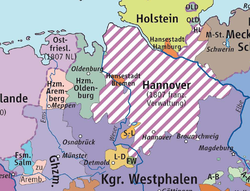Duchy of Arenberg-Meppen
| County (Duchy) of Arenberg | ||||||||||||||||
| Grafschaft (Herzogtum) Arenberg | ||||||||||||||||
|
State of the Holy Roman Empire, then State of the Confederation of the Rhine |
||||||||||||||||
|
||||||||||||||||
|
The Duchy of Arenberg in 1807
|
||||||||||||||||
| Capital | Aremberg | |||||||||||||||
| Languages | Moselle Franconian | |||||||||||||||
| Government | Principality | |||||||||||||||
| Historical era |
Middle Ages Early modern period |
|||||||||||||||
| • | County established | c. 1117 | ||||||||||||||
| • | Gained Reichsfreiheit | 1549 | ||||||||||||||
| • | Raised to Princely county | 1576 | ||||||||||||||
| • | Joined Council of Princes | 1580 | ||||||||||||||
| • | Raised to Duchy | 1645 | ||||||||||||||
| • | Joined Confederation of the Rhine |
1806 |
||||||||||||||
| • |
Mediatized to Hanover and Prussia |
1810 | ||||||||||||||
| Area | ||||||||||||||||
| • | 1798 | 413 km2 (159 sq mi) | ||||||||||||||
| Population | ||||||||||||||||
| • | 1798 est. | 14,800 | ||||||||||||||
| Density | 36/km2 (93/sq mi) | |||||||||||||||
|
||||||||||||||||
Arenberg, also spelled as Aremberg or Ahremberg, is a former county, principality and finally duchy that was located in what is now Germany. The Dukes of Arenberg remain a prominent Belgian noble family.
First mentioned in the 12th century, it was named after the village of Aremberg in the Ahr Hills, located in today's Rhineland-Palatinate region of Germany.
Aremberg was originally a county. It became a state of the Holy Roman Empire (reichsunmittelbar) in 1549, was raised to a princely county in 1576, then became a duchy in 1645.
The territorial possessions of the Dukes of Arenberg varied through the ages. Around 1789, the duchy was located in the Eifel region on the west side of the Rhine and contained, amongst others, Aremberg, Schleiden and Kerpen.
However, although the duchy itself was in Germany, from the 15th century onward, the principal lands of the Dukes of Arenberg have been in what is now Belgium.
The pre-Napoleonic duchy had an area of 413 km² and a population of 14,800. It belonged to the Electoral Rhenish Circle and was bordered by the duchy of Jülich, the Archbishopric of Cologne, the Archbishopric of Trier, and the county of Blankenheim.
...
Wikipedia



